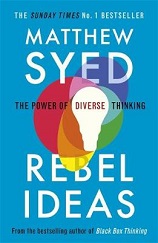
Hi there, energy systems enthusiasts and craft lovers and gardeners alike!
As someone who splits her time between accelerating clean energy tech and scribbling patterns on greeting cards or gardening, I’m always curious about how diverse thinking shows up in different worlds. While recently listening to Matthew Syed’s “Rebel Ideas: The Power of Diverse Thinking” on audiobook, I found myself drawing parallels to my work at PNDC, where decarbonising energy systems requires more than just technical expertise—it demands radically inclusive collaboration. Here are my takeaways and how they resonate with both my professional and creative life.
1. Real-Life Examples = Real-World Impact
Syed’s story about people hesitating to speak up even in life-threatening situations struck me hard. At first glance, it seems absurd—“Why wouldn’t anyone demand help?”—but the book unpacks how cultural norms and structural hierarchies can silence voices. In my work leading hydrogen projects, I’ve witnessed this. For instance, during a brainstorming session on grid integration challenges, a junior researcher tentatively suggested an idea that ultimately prevented a flawed design. The courage to voice concerns, even respectfully, turned a potential setback into progress. Syed reminds me that growth thrives in environments where dissent is welcome. But let’s also remember that not everything requires a dissent or is a war. We must learn to pick our battles, focusing energy on ideas that truly reshape our direction.
2. HiPPOs and the Art of Letting Go of “Seniority”
One line that made me smile: “HiPPOs rule the room.” For those hearing HiPPOs for the first time, it stands for ‘Highest Paid Individual’s Opinion’. Don’t we all know a person whose rank determines the room’s focus? In many organisations I’ve worked with, the loudest opinions often belong to those with the highest paychecks—yet the most innovative solutions often come from listening deeply, not speaking over others. In our R&D team meetings, I’ve started asking colleagues to pause debates and reframe conversations: “Let’s not argue who has the ‘best’ idea, or which is the best idea, but rather explore how cross-functional teams can combine insights.” This shift in dynamics not only democratizes innovation but also taps into the wisdom of the crowd, which, ironically, often validates the best ideas anyway!
3. “Bring Me a Solution” vs “Let’s Solve It Together”
“Don’t come to me with a problem, bring me a solution!” That’s a mantra many professionals learn early on. But Syed pushes back: skipping the problem stage misses the boat on diverse thinking. Early in my career, I fell into that trap, crafting “polished proposals”. Now, I advocate for collaborative problem-solving in our projects. For example, our recent heat decarbonization advisory group involved open forums where stakeholders— engineers from different disciplines, policy and social scientists—started with questions rather than answers. The resulting plans were more robust simply because we started the mental sprint together.
4. Rebels > Clones: Why “Very Different” Outperforms “Very Similar”
This chapter hit home. Syed argues that successful advisory groups aren’t just diverse in age, gender, or background—they’re diverse in expertise. Think about it: how many energy panels consist only of energy insiders? Not great! At a recent Ofgem webinar introducing their Strategic Innovation Fund Round 5 challenges around consumer-centric innovation, I was blown away by a presentation from a water company that had hosted water-themed innovation festivals for eight years. Their structured approach to ideation, MVPs, and collaboration was worlds away from traditional energy-sector methods—and yet, their cross-industry perspective revealed fresh strategies for tackling grid scalability issues. This is the magic of “rebels,” not “clones.”
5. Ideas Flourish in Open Spaces
Syed’s line about “birds of the same stock” reminded me of my own tendencies. As an electrical engineering grad, I’ve always defaulted to electrical conferences. But earlier this year, I was invited to present at a mechanical engineering symposium. The resulting conversations—about material sciences, nuclear reactor designs, even industrial cooling systems—unexpectedly inspired a modular energy storage idea for rural electrification in our portfolio. Socializing ideas across disciplines doesn’t just break silos; it reveals new pathways we couldn’t see in our own “flock.”
Side note: Socialising ideas takes effort. Like trying a new cuisine while I’m used to Indian. But the reward is worth it!
6. Averages Are Lousy Guides for Individuality
This chapter on personalised diets had a surprising edge—yes, even though a delegate from a precision health startup in the audiobook audience made it seem a bit sceptical for me! The pushback against one-size-fits-all solutions mirrors my work in energy. For example, heat decarbonisation isn’t viable with a single technology in every school or hospital. Just as we need tailored diets for diabetes management, we need localised, adaptive solutions for buildings, which have wildly different energy profiles. Syed’s point is simple: data and policy mustn’t homogenise people’s needs into averages.
Personal resonance: My switch to audiobooks was also about seeking personalised engagement. How many more books could I devour by listening to stories while kneading dough or tending the garden?
Putting Rebel Thinking to Work
For me, “Rebel Ideas” is a call to build environments where comfort zones feel like crutches and new perspectives feel like superpowers. Here’s how I apply it:
- Create “safe spaces” for late-stage challenges to technical plans.
- Invite non-energy experts to energy conversations (less obvious, more powerful).
- Start collaborations with questions, not solutions—then iterate with the crowd.
- Design solutions for individuals, not abstractions.
Final Thought:
In a world obsessed with efficiency and carbon neutrality, perhaps the most radical act we can take is to listen to outliers—whether they’re lovely rebels from other fields or quietly rebellious minds in the room. Progress isn’t a solo effort, but a collective glow. In both innovation and everyday creativity, diversity isn’t an accessory—it’s the fuel. So, what will be your next rebel idea?
Stay curious, stay rebellious, and let’s grow those brains together, one diverse conversation at a time!
